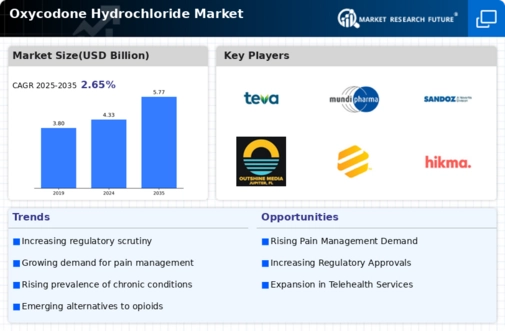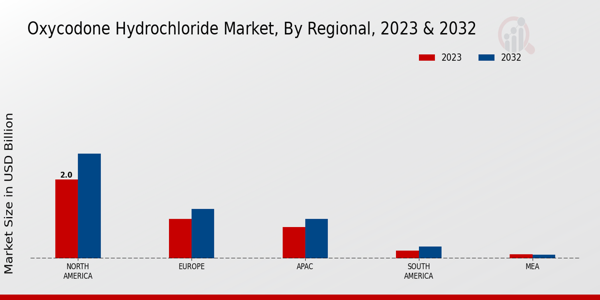Global Awareness Campaigns
Awareness campaigns aimed at educating both healthcare professionals and patients about pain management options are influencing the Global Oxycodone Hydrochloride Market Industry. These initiatives emphasize the importance of understanding pain management and the role of opioids, including oxycodone hydrochloride, in treatment plans. By increasing knowledge and reducing stigma associated with opioid use, these campaigns may lead to higher prescription rates and responsible usage. As healthcare providers become more informed about the benefits and risks of oxycodone hydrochloride, the market is expected to see sustained growth, reflecting the evolving landscape of pain management.
Rising Geriatric Population
The Global Oxycodone Hydrochloride Market Industry is poised for growth due to the increasing geriatric population, which often experiences chronic pain conditions. As individuals age, the prevalence of ailments such as osteoarthritis and neuropathic pain rises, leading to a higher demand for effective analgesics. This demographic shift is prompting healthcare systems to adapt their pain management strategies, incorporating oxycodone hydrochloride as a viable option. The growing recognition of the need for tailored pain management solutions for older adults is likely to contribute to the market's expansion in the coming years.
Market Trends and Projections
The Global Oxycodone Hydrochloride Market Industry is characterized by various trends and projections that indicate its future trajectory. The market is anticipated to grow from 4.33 USD Billion in 2024 to 5.77 USD Billion by 2035, with a CAGR of 2.64% projected for the period between 2025 and 2035. These figures suggest a steady increase in demand for oxycodone hydrochloride, driven by factors such as the rising prevalence of chronic pain conditions and advancements in drug formulations. The market dynamics are likely to evolve, reflecting the ongoing changes in healthcare practices and patient needs.
Increasing Pain Management Needs
The Global Oxycodone Hydrochloride Market Industry is experiencing growth due to the rising demand for effective pain management solutions. Chronic pain conditions, such as arthritis and cancer, are becoming more prevalent, leading to a higher prescription rate of opioids, including oxycodone hydrochloride. In 2024, the market is projected to reach 4.33 USD Billion, reflecting the urgent need for potent analgesics. Healthcare providers are increasingly recognizing the importance of addressing pain comprehensively, which further drives the adoption of oxycodone hydrochloride in treatment protocols. This trend suggests a sustained demand for this medication in the foreseeable future.
Advancements in Drug Formulations
Innovations in drug formulations are significantly impacting the Global Oxycodone Hydrochloride Market Industry. Pharmaceutical companies are developing extended-release formulations that provide prolonged pain relief while minimizing the risk of abuse. These advancements are crucial in addressing the ongoing concerns regarding opioid addiction and misuse. By offering safer alternatives, the market is likely to attract a broader patient base, thereby enhancing its growth potential. The introduction of these formulations aligns with the projected CAGR of 2.64% for the period from 2025 to 2035, indicating a positive outlook for oxycodone hydrochloride as a preferred choice in pain management.
Regulatory Support for Opioid Use
The Global Oxycodone Hydrochloride Market Industry benefits from regulatory frameworks that support the use of opioids for pain management. Governments and health organizations are establishing guidelines that promote the responsible prescribing of opioids, including oxycodone hydrochloride, to ensure patients receive adequate pain relief. This regulatory support is crucial in balancing the need for effective pain management with the risks associated with opioid use. As a result, the market is expected to grow steadily, with projections indicating a market size of 5.77 USD Billion by 2035. Such regulatory measures may enhance the credibility and acceptance of oxycodone hydrochloride in clinical settings.












